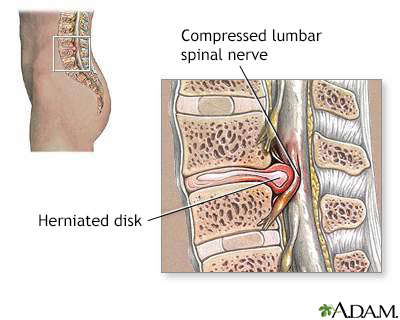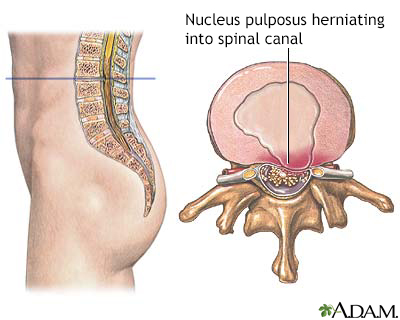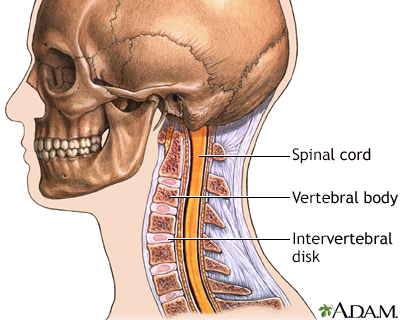| Low back pain glossary |
Click a word on the left and the definition will appear here:
|
Click a word on the left and the definition will appear here:
Acupuncture: A treatment based on Traditional Chinese Medicine (TCM), a system of healing that dates back thousands of years. Thin needles are placed into the patient's skin for about 15 - 60 minutes. Acupuncture may produce complex effects on the brain and the body and may be helpful for back pain. Most states require acupuncturists to be licensed and confer a title (LAc) that these acupuncturists can use to identify themselves.

Click a word on the left and the definition will appear here:
Acute low back pain: "Acute" means the back pain lasts less than 1 month. Most cases clear up within 1 week, even without medical attention. However, recurrence of the pain after a first attack is common. (Compare acute to CHRONIC.)

Click a word on the left and the definition will appear here:
Arthritis: A disease that involves inflammation of one or more joints. ("Arthr" refers to joints, and "itis" to inflammation.) Joint inflammation is the body's reaction to various disease processes. Osteoarthritis is the most common type of arthritis in the United States. This arthritis often results from years of accumulated "wear and tear" on joints, and tends to occur in the elderly in hips, knees, and finger joints. Rheumatoid arthritis involves an attack on the body by its own immune cells. (It is an auto-immune disease.)

Click a word on the left and the definition will appear here:
Cartilage: Tissue in the vertebral disk that helps cushion and protect the vertebrae, allowing your spinal column to move more freely. (Cartilage is also the soft, rubbery tissue that makes up your nose and ears.) See also Disk.

Click a word on the left and the definition will appear here:
Cauda Equina Syndrome: The cauda equina is formed by the nerve fibers in the lowest part of the spinal column. These fibers are sometimes called "the tail" of the spinal cord. In cauda equina syndrome, these fibers become compressed, frequently by a large herniated disk. You can lose control of bladder and bowel function. You may also feel dull pain or weakness or numbness in your buttocks, genital area, and thighs.

Click a word on the left and the definition will appear here:
Chiropractor: A health care provider who diagnoses illnesses of the nerves, muscles, bones, and joints of the body. Spinal manipulation is the most common technique used by chiropractors. Chiropractors are licensed in all 50 states.
Click a word on the left and the definition will appear here:
Chronic low back pain: "Chronic" means the back pain persists beyond 3 months. It is long-term, continuous, or ongoing. A very small number of people have chronic low back pain after their initial episode of pain. (Compare chronic to ACUTE.)

Click a word on the left and the definition will appear here:
COX-2 inhibitors: Medications that reduce inflammation and pain. They are safer for your stomach and have fewer side effects than NSAIDs. These medicines can, however, increase your risk for heart attack and stroke. An example of a COX-2 inhibitor is celecoxib (Celebrex).
Click a word on the left and the definition will appear here:
CT scan: A method of body imaging where the x-ray beam rotates around you. Small detectors measure the amount of x-rays that make it through the body area of interest. These images can be stored, viewed on a monitor, or printed on film. In addition, three-dimensional models of organs can be created by stacking the individual images, or "slices."

Click a word on the left and the definition will appear here:
Degeneration: When a body part (such as bone) weakens and deteriorates.
Click a word on the left and the definition will appear here:
Disk: The flat plate between each vertebra that cushions it. The disk has an outer covering made up partly of cartilage. The center of the disk has a jelly-like substance called the nucleus pulposus, which acts like a rubber ball to provide cushioning during compression. Each disk is like a shock absorber during physical activity, such as walking, jumping, or lifting, and allows the spine to extend and flex.

Click a word on the left and the definition will appear here:
Extrusion: When a large amount of disk material herniates into the spinal canal.

Click a word on the left and the definition will appear here:
Herniation: When the jelly-like substance (nucleus pulposus) within a vertebral disk bulges outward. This is usually because the disk has become very thin and weak. There are different degrees of herniation. Many people have slight bulging that causes no pain. Others have an extensive bulge (called an extrusion) or an actual rupture of the disk, which may cause pain.

Click a word on the left and the definition will appear here:
Ligament: Tissue that connects bones and holds them together.

Click a word on the left and the definition will appear here:
Lumbar vertebrae: The 5 vertebrae in your lower back.

Click a word on the left and the definition will appear here:
Massage: A "hands-on" therapy in which muscles and other soft tissues of the body are manipulated to improve health and well-being. There are nearly 100 different massage and body work techniques. These range from gentle stroking and kneading to deeper manual techniques. Certified massage therapists complete a training program of 500 or more hours, take national board exams, and are licensed or registered in 29 states.
Click a word on the left and the definition will appear here:
MRI: Magnetic resonance imaging -- a non-invasive procedure that uses powerful magnets and radio waves to construct pictures of the body based on their water content.

Click a word on the left and the definition will appear here:
Muscle relaxant: A drug used to treat muscle spasm (tension in your muscles). Muscle relaxants don't actually work at the muscles. They work by telling your brain to relax the muscles. These medications may make you feel drowsy, and they do have the potential to be abused and lead to addiction.
Click a word on the left and the definition will appear here:
Muscle spasm: When a very tense muscle remains contracted.
Click a word on the left and the definition will appear here:
Narcotics: A type of painkiller reserved for pain that is severe and not helped by other types of painkillers. Narcotics work by blocking your feeling of pain. These medications may make you feel drowsy, and they do have the potential to be abused and lead to addiction. Examples include codeine, meperidine (Demerol), morphine (MS Contin), oxycodone (Percocet, Percodan), and tramadol (Ultram).
Click a word on the left and the definition will appear here:
Nerve condition tests: A way to study the activity and function of your nerves. Electrodes are placed on your skin and you are given small electrical shocks. With these shocks, the speed with which your nerves conduct the signal is measured.
Click a word on the left and the definition will appear here:
Neurologist: A physician (MD) who specializes in nerve disorders and diseases, including the nerves that make up the spinal cord.
Click a word on the left and the definition will appear here:
NSAIDs: Non-steroidal anti-inflammatory drugs -- the most commonly used type of medication for back pain. They work by blocking a substance called prostaglandin. Prostaglandins dilate blood vessels (leading to increased blood flow) and promote inflammation, both of which can cause pain. NSAIDs are available over-the-counter or by prescription. The prescription versions are generally stronger and longer lasting. Examples include ibuprofen (Motrin), naproxen (Anaprox, Naprosyn), tolmetin (Tolectin), and many others. Side effects include stomach ulcers, bleeding, high blood pressure, and possible kidney damage.
Click a word on the left and the definition will appear here:
Orthopedist: A physician (MD) who specializes in treating bone, joint, muscle and nerve problems. They are trained to use both non-surgical and, when necessary, surgical interventions to treat injuries and disorders of the spine and the arms and legs. Many orthopedists receive additional, high level training to sub-specialize in areas such as spine surgery, sports medicine, hand surgery, and joint reconstruction.
Click a word on the left and the definition will appear here:
Osteopathic doctor: A health care provider who specializes in diseases affected by the muscles, bones, and soft-tissues like cartilage, tendons, and ligaments. Doctors of osteopathy (D.O.s) receive the same basic training as medical doctors (M.D.s). D.O.s also practice hands-on adjustments of muscles, bones, and ligaments, using these in addition to more conventional medical treatments. Most D.O.s are primary care practitioners, specializing in family medicine, internal medicine, obstetrics/gynecology, or pediatrics. A few can be found in other medical specialties as well. D.O.s have full practice rights in all 50 states.

Click a word on the left and the definition will appear here:
Osteoporosis: The thinning of bone tissue and loss of bone density over time. Throughout youth, the body uses calcium and phosphate to produce bone and increase bone mass. After the age of about 20, people start slowly loosing bone mass. This loss of bone may be accelerated in certain situations, such as menopause or prescription steroid use, and the bones can become significantly weaker and subject to fractures, even in the absence of trauma. Weak bones can also result from a poor diet or certain diseases.

Click a word on the left and the definition will appear here:
Physical therapist: A licensed health care provider who specializes in helping people recover from injuries and diseases. They focus on helping people regain movement, take care of themselves, and function at work or home.
Click a word on the left and the definition will appear here:
Recurrent back pain: Getting back pain more than once. This is not the same as continuous, chronic, or long-term pain.
Click a word on the left and the definition will appear here:
Ruptured disk: A disk that actually tears, releasing the gelatinous nucleus pulposus into the spinal canal.

Click a word on the left and the definition will appear here:
Sciatica: Pain that runs along the outside of your leg and often accompanies low back pain. The sciatic nerve is a large nerve that travels down the hip sending branches all the way to your foot. If the sciatic nerve gets trapped or inflamed anywhere along this route, you may feel pain.

Click a word on the left and the definition will appear here:
Spine: A column of small bones, called vertebrae, that run along the center of your back. The vertebrae support your trunk and protect the spinal cord.

Click a word on the left and the definition will appear here:
Spinal cord: The bundle of nerves that runs through the spinal vertebrae. The nerves of the spinal cord connect your brain to all of the organs and tissues of your body.

Click a word on the left and the definition will appear here:
Spinal manipulation: The process of manually moving the vertebrae (spinal bones). Performed by a therapist, chiropractor, or osteopathic doctor.
Click a word on the left and the definition will appear here:
Spinal stenosis: Narrowing of the spinal canal that can cause pain by pushing on spinal nerves.

Click a word on the left and the definition will appear here:
Steroid: A potent anti-inflammatory drug that can be injected into the area of pain, used especially if your back pain persists for longer than a month. Steroids reduce inflammation and pain.
Click a word on the left and the definition will appear here:
Vertebra: A segment of bone in the spinal column. The plural is vertebrae.

|
Review Date:
6/29/2011 Reviewed By: Andrew W. Piasecki, MD, Camden Bone and Joint, LLC, Orthopaedic Surgery/Sports Medicine, Camden, SC. Review provided by VeriMed Healthcare Network. Also reviewed by David Zieve, MD, MHA, Medical Director, A.D.A.M., Inc. |

